Computer-Assisted Reading Strategy.
An optional supplement to other reading programs.
Adjustable to the needs of any age group.
If you have a desktop or laptop computer available for use in teaching a person to read, then three resources here at the ALC web site can be brought together at no cost to assist persons who're learning to read. These resources require an instructor or guiding adult to assemble the materials for the purpose of assisting a child, an ESL student, an illiterate adult, a high-school dropout - or any person who is to be guided into English literacy. The composite collection of these resources results in a new strategy for individualized teaching of reading.
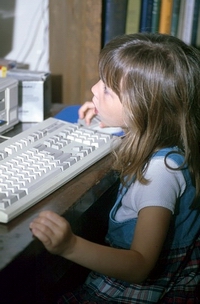
These resources are needed:
First, you must provide your own desktop or laptop computer. It must have speakers or an earphone headset through which various English words will be spoken aloud.
1. The supervising adult must print the list of seven thousand English words that happen to be in phonetic form just as they are. These are normal English words that happen to use letters quite accurately to signify the sounds that should be imagined or spoken. They're published for the first time here on this web site.
2. The Sound-Write(r) software must be downloaded and installed on your local computer. Sound-Write won't run on network servers. It must be installed on individual computers. The adult teacher or guiding parent must learn how to bring up Sound-Write and put it to use. The Instructors Guide and a separate User Manual reveals the benefits. It's quite obvious how to use the software.
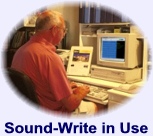 Lest you give up too soon on this proposed method, you need to know that the computer is going to correct 90% of the misspelled words that the student may type. However silly their attempts may be when inventing the way to spell a word, the computer will almost always figure out the intention and promptly display a correctly-spelled word. However inexperienced the pupil may be, his or her screen soon fills with correctly spelled words. As the pupil types, the corrected words are instantly spoken through speakers or head-phones for the student to hear.
Lest you give up too soon on this proposed method, you need to know that the computer is going to correct 90% of the misspelled words that the student may type. However silly their attempts may be when inventing the way to spell a word, the computer will almost always figure out the intention and promptly display a correctly-spelled word. However inexperienced the pupil may be, his or her screen soon fills with correctly spelled words. As the pupil types, the corrected words are instantly spoken through speakers or head-phones for the student to hear.
The guiding adult should print the instruction and user manuals to gain understanding of the numerous ways in which Sound-Write provides instantaneous feedback to learners.
3. A beginner's list of sentences and words are provided here (further below) as examples of the types of practice words and sentences that can be created by the parent/supervisor specifically for the age level and interests of each individual pupil.
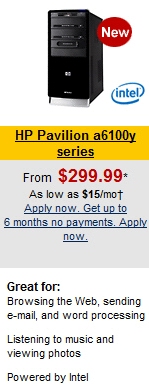
NOTE: The Sound-Write software is meant to be used ONLY for a few weeks or months. Once a learner has grasped the concept that letters and syllables can be generally trusted to signal various speech sounds (based on the 7,000 phonically pure word list), and once the learner begins to successfully invent and spell words independently, they should be moved to a robust text editor such as "Notepad" (tm), "EditPad-Lite", MS-Word - or any equivalent word processing program.
REGARDING YOUR COMPUTER:
If you don't have a computer, then observe this product ===>
It was located by doing a web search for "computers low cost."
This was one of many places where hardware costing between $299 and $399 was listed. These are new warranted computers and they can be upgraded at purchase time if you order on the internet or by phone. The Sound-Write software will run on these types of computers. The monitor isn't included in this price. But for $15 or $20 per month you can obtain a basic computer for this special learning purpose. Most computers arrive with an operating system, a web browser, e-mail, and other common computer software.
Similarly, laptop computers are available between $250 and $350 dollars. They include a screen, of course, and have similar capabilities to desk-top computers - plus portability, battery, and modem. For very small children, they may not be adequately robust and break-proof, however.
REVIEWING THE SOUND-WRITE SOFTWARE:
Assuming that the student (child or adult) can recite the letters of the alphabet, they'll be using the computer keyboard to peck in specific letters, words, or short sentences. Words and sentences from worksheets can also be displayed in the right panel of the Sound-Write screen (See instructor's guide.)
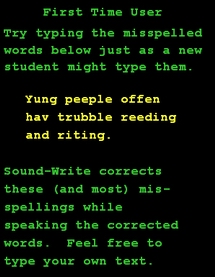 The adult supervisor can create his or her own lists of words or sentences, based on the age level and interests of the student.
Whether pupils punch in letters correctly or with mistakes, the computer will (almost always) instantly correct the word, and then will speak the word through earphones or out of the computer speakers.
The adult supervisor can create his or her own lists of words or sentences, based on the age level and interests of the student.
Whether pupils punch in letters correctly or with mistakes, the computer will (almost always) instantly correct the word, and then will speak the word through earphones or out of the computer speakers.
Sound-Write's ability to correct misspelled words is uncanny. Ninety percent of the misspelled words will be corrected. Any number of extra letters can be inserted by the pupil and the computer will eliminate them. Vowels may be wrong, and letter order may be misplaced but each word will be corrected in most cases.
The screen is not filled with misspelled words despite the mistakes that a student may make. Here's a captured example of two misspelled words - with explanations. Click within the black button-box to hear the voice.

Following below is a full sentence example - already corrected by the computer. On the left side the student can click on "READ SENT." Click within the graphic below to hear it spoken at normal speed.

Sometimes a student will need to hear a sentence spoken very slowly -
as this partial clip demonstrates:
The left bar on the Sound-Write screen looks like this - mostly for use by the student.

If a student moves the cursor back over the word CARPET and clicks the right mouse button several times, he or she will hear the word repeated once for each click. It sounds like this:
Suppose the student needs to hear the spelling of a word. They would left-click the mouse-cursor to rest inside a word, then move to the left side bar and click on SPELL WORD.
It would sound like this:
SOME THOUGHTS ABOUT THE VOICE
An initial reaction is that the voice sounds a bit robotic, not quite human, not quite like the television newscaster, not like the man a woman would want to live with. RIGHT?
Don't reject this learning tool because of the voice. The voice quality will not handicap the student's progress during the 4 to 10 weeks that you'll be using Sound-Write. There's no other tool quite like this one - definitely none that can correct tens of millions of misspelled words on the fly.
The word DEMOCRACY can be spelled over 4,000 wrong ways and any number of extra letters can be typed by mistake and the computer will correct the misspelling. For example, "Dumokrasy, Dimocrasie, Demmoccccrasy, Deeeeeemokrasssie, Doomakrasy, Duuummoocressssssy" on and on. The invented spellings of novice learners are instantly corrected. No other teaching tool can do this. The methods employed to correct misspellings are a trade secret.
The cost of licensing a better voice for this software prohibits improving it. The ALC was fortunate that the former DecTalk company granted the right to distribute this standalone version of their product for use in non-profit institutions and homes where parents may be tutoring their children.
Is is possible to correct the pronunciation where you hear a few words spoken inaccuratly. There's a way to tune such individual words and the documentation could be provided. Some words have been adjusted already. But it takes perhaps 45 minutes per word - tuning, improving, and testing. However it would be less costly if the few poorly-spoken words were just omitted from work sheets in those instances where there's annoyance about how an individual word is pronounced.

Remember, this is a tool that should only be used for 30 to 60 days while the pupil is gaining confidence that letters can be trusted to signal what sounds ought to be imagined or spoken. Further investment may not be justified.
Sound-Write can be downloaded from here. You'll return to this page when finished.
Download Sound-Write
The next free resource is the list of 7,000 phonically-pure English words. These special words use letters quite uniformly and consistently. These words are valuable for building your own word lists and sentences for practice assignments for each individual student - adjusted for the student's age and personal interests.
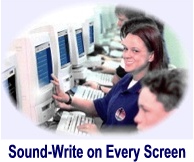
Building these sentences requires some time and thought because words that you might expect to be able to use may not be in the list. Actually any list of 7,000 words ought to enable almost any idea to be expressed for beginning-readers even if some favorite words can't be used.
Why are 36,000 out of 44,000 English words missing from this list? The missing words have extra letters in them. They have hundreds of ways in which vowels are expressed without uniformity, and thousands of consonants switched and swapped. The only spelling rule with no exception is that no English word ends in "V."
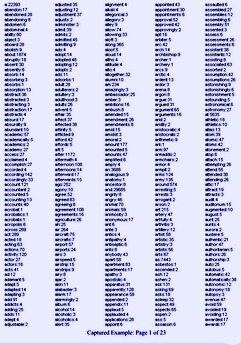
For example, there are 17 variant ways to signal the "EE" sound as in FEET. But there's no need for an "E" on the end of QUITE. And there's no "EE" in SKI even though there should be. The 39,000 missing English words are words with confusing, misplaced letters often dropped in randomly.
Inconsistent spellings: That's exactly what you don't want little children or adult learners to see during their initial experiences with spelling and reading. If shown prematurely, the 36,000 words that are not in proper phonic form can bring learning to a stand-still before they get started because they sense that letters can't be trusted. If you display words randomly as other workbooks often do, the advantage of phonics will never be realized. The beauty of phonically-spelled words is that by design, one or two letters represents one speech sound in phonics every time.
Beginners can sense in the first few sessions whether there's hope for going further. If they determine there really are no rules, and that you can't trust letters to suggest pronunciation unless you just memorize the shape of words like Chinese characters, you may lose the student. Adult learners don't have time or talent for sheer memorization. And little children can be led into developmental dyslexia if they fail to grasp the real key to reading - that letters enable syllables to be sounded out.
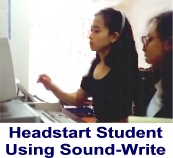
The benefit of displaying phonically-pure words is gained from the uniformity of letter-use in these isolated words. Over and over the beginner will notice that the "EE" sound in FEET is the same "EE" sound in a hundred other words also - reliable and reasonable. That experience makes it abundantly clear to the learner - but only if you use words from this unique list of 7,000 words that are quite phonically pure.
There's convincing research showing that little children who memorize easily, and who enjoy the rewards that come from it, can be severely damaged later when sheer memorization of the general appearance of words becomes an overwhelming chore on the way to eventually reading the adult mix of 44,000 commonly used words. The sounding out of syllables that consistently represent sounds avoids that problem completely. Memorizing the appearance of words is a discarded strategy, tried several times in history, and with damaging outcomes.
We propose here that only the 7,000 English words that are already in phonic form should be used with beginning students. The pupil must notice that letters in these 7,000 basic words do consistently signal the sounds that ought to be imagined or spoken. Once that foundation is grasped by a student, variations expressed in the other 39,000 words can be slowly introduced. When entering that second phase, you can introduce words that contain "TION" as in NATION, PREVENTION, CONNECTION, and two thousand others. TION represents "SHUN" reliably 90% of the time, as in CREATION. Similarly, words beginning with "C" and "K" might be gradually introduced next. Words involving PH and F might be next, etc.
Here's the list of 7,000 phonically pure words in alphabetical order. They're best used to create short or long sentences for students to use in practice assignments. This is a PDF file requiring the Adobe Reader. It's not useful unless printed. Prepare to print 23 pages. Allow ample time for loading.
Baseline list of 7,000 phonic words in alphabetic order (PDF file)
Next, the same 7,000 words are sorted by frequency. How many times does each word appear in one million words of random text? The most popular (most important words perhaps) floated to the top in this listing. This list doesn't help much during the invention of practice sentences, but the printed copy can be used for reference. You may wonder about which words deserve early and repeated exposure. Frequently-used words are on the first three or four pages of this file. You might consider just printing the first three or four pages so that you can see the most important words a student ought to be encountering.
Baseline list of 7,000 phonic words in order by frequency of use (PDF file)
There are six other lists of words including the full list of 44,000 most-used words which are displayed at the bottom of the ESL section of this web site. Those lists are of interest largely to researchers and so-called "word tinkerers." Those files are in Excel spread sheets and can be searched in many creative ways by graduate students and scholars.
 If you haven't encountered this already, Dr Edward Rondthaler devoted 25 years exclusively to researching and producing a phonic version of all 44,000 words. Letter's are used consistently throughout his published corpus of 44,000 words. See the story of his research elsewhere on this site. It was a monumental contribution. No pronunciation guide would be needed if that simplified or reformed spelling standard could be brought into popular use.
If you haven't encountered this already, Dr Edward Rondthaler devoted 25 years exclusively to researching and producing a phonic version of all 44,000 words. Letter's are used consistently throughout his published corpus of 44,000 words. See the story of his research elsewhere on this site. It was a monumental contribution. No pronunciation guide would be needed if that simplified or reformed spelling standard could be brought into popular use.
Because of his effort, it became visible that there were about 7,000 words that didn't need to be reformed. They couldn't be simplified because their normal spelling was already phonically pure.
We call this the BASE-LINE word list - words that ought to be exposed first to beginning students. The list is made public here for the first time in the hope that teachers and parents who grasp the reasonableness of the phonics method, and who recognize that English-speaking countries have ever-increasing numbers of illiterates, will use this list in the battle against illiteracy.
The final resource is a down-loadable list of sentences for use in practice worksheets. These sentences are simple and quite obvious as to their purpose. Some are stilted because the vocabulary is limited to the phonic word list above. They aren't segregated by age group. Some of them are already loaded into the Sound-Write software for display in the small right-side panel of the Sound-Write screen. Use these sentences as starter-templates or as suggestive ideas.
You can download the file in either PDF or RTF rich text format.
Sentences for Student Assignments (PDF file)
Sentences for Student Assignments (RTF-Word file)
While not required, if you use part or all of these word lists in publications, please reference this Web site which is http://AmericanLiteracy.com .